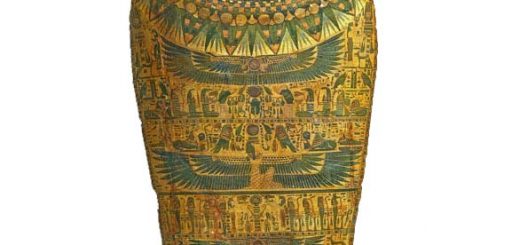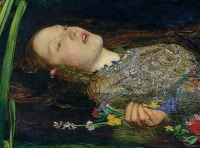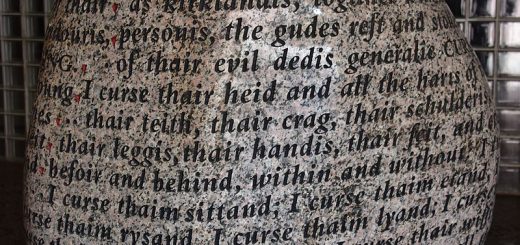The Dead Hand
The “Dead Hand,” or the “Holy Hand,” as it is sometimes styled, alluded to in the foregoing tradition,is the centre around which quite a galaxy of marvellous tales have gathered. It is known to have belonged to Father Edmund Arrowsmith, a Jesuit, who suffered the extreme penalty of the law at Lancaster, on the 28th August 1628.
The cause of Father Arrowsmith’s trial and execution has been variously stated, certain sceptical persons alleging that he had been found guilty of some foul crime, and that the tale of his martyrdom for the sake of his faith, and the miracles which attest his sanctity, have been invented for the purpose of preventing scandal in the Church. The onus probandi lies, of course, with them, and until these unbelievers in miraculous intervention can adduce any evidence on behalf of their allegations, there does not appear to be any reason for refusing to accept the testimony of the Catholics, which is to the following effect.
Arrowsmith was born at Haydock, in the parish of Winwick, Lancashire, in 1585. In 1605 he entered the Jesuit College at Douay, and in 1612 was ordained priest. The next year he was sent on a mission to England; and in 1623 was apprehended and taken to Lancaster on a charge of being a Eomish priest, contrary to the laws “in that case made and provided.” He was tried for this offence, found guilty, sentenced to death, and executed. After his body was cut down one of his friends or, as other accounts say, his spiritual attendant, cut off his right hand, in compliance with his dying injunctions, and to fulfil his dying promise that he should work miraculous cures on those who had faith in its efficacy.
 For many years the hand was kept at Bryn Hall, and when that ancient edifice was demolished it was removed to Garswood Hall, Sir Robert Gerard’s residence. Ultimately it was placed in the Catholic Chapel at Ashton-in-Maskerfield, where it now is in custody of the priest. This holy relic, by which so many marvellous cures have been wrought, is most carefully preserved in a white silk bag. We have before us an account of a case which occurred in August 1872: a woman named Catherine Collins, was sent to the Wigan Workhouse a wholly destitute. She had been sitting all day on a door-step, after having come out of the workhouse at Salford on leave, and walked all the way from that town to Mackerfield, in order to have the “Holy Hand” applied to her side, which was paralyzed. When her case came before the Wigan Board of Guardians, Mr. Clarke, one of the guardians for Ashton, informed the Board that hundreds of persons visited the township on a similar errand to that of this paralytic woman.
For many years the hand was kept at Bryn Hall, and when that ancient edifice was demolished it was removed to Garswood Hall, Sir Robert Gerard’s residence. Ultimately it was placed in the Catholic Chapel at Ashton-in-Maskerfield, where it now is in custody of the priest. This holy relic, by which so many marvellous cures have been wrought, is most carefully preserved in a white silk bag. We have before us an account of a case which occurred in August 1872: a woman named Catherine Collins, was sent to the Wigan Workhouse a wholly destitute. She had been sitting all day on a door-step, after having come out of the workhouse at Salford on leave, and walked all the way from that town to Mackerfield, in order to have the “Holy Hand” applied to her side, which was paralyzed. When her case came before the Wigan Board of Guardians, Mr. Clarke, one of the guardians for Ashton, informed the Board that hundreds of persons visited the township on a similar errand to that of this paralytic woman.
[The Haunted Homes and Family Traditions of Great Britain by John Ingram (1897)]





Re: The Dead Hand
STRANGE PAGES FROM FAMILY PAPERS (1895) By T.F. THISELTON DYER
Among other qualities which have been supposed to belong to a dead man’s hand, are its medicinal virtues, in connection with which may be mentioned the famous "dead hand," which was, in years past, kept at Bryn Hall, Lancashire. There are several stories relating to this gruesome relic, one being that it was the hand of Father Arrowsmith, a priest, who, according to some accounts, is said to have been put to death for his religion in the time of William III. It is recorded that when about to suffer he desired his spiritual attendant to cut off his right hand, which should ever after have power to work miraculous cures on those who had faith to believe in its efficacy. This relic, which forms the subject of one of Roby’s "Traditions of Lancashire," was preserved with great care in a white silk bag, and was resorted to by many diseased persons, who are reported to have derived wonderful cures from its application. Thus the case is related of a woman who, attacked with the smallpox, had this dead hand in bed with her every night for six weeks, and of a poor lad living near Manchester who was touched with it for the cure of scrofulous sores.
It has been denied, however, that Father Arrowsmith was hanged for "witnessing a good confession," and Mr. Roby, in his "Traditions of Lancashire," says that, having been found guilty of a rape, in all probability this story of his martyrdom, and of the miraculous attestation to the truth of the cause for which he suffered, were contrived for the purpose of preventing the scandal that would have come upon the Church through the delinquency of an unworthy member. It is further said that one of the family of the Kenyons attended as under-sheriff at the execution, and that he refused the culprit some trifling favour at the gallows, whereupon Arrowsmith denounced a curse upon him, to wit, that, whilst the family could boast of an heir, so long they never should want a cripple – a prediction which was supposed by the credulous to have been literally fulfilled. But this story is discredited, the real facts of the case, no doubt, being that he was hanged "under sanction of an atrocious law, for no other reason but because he had taken orders as a Roman Catholic priest, and had endeavoured to prevail upon others to be of his own faith." According to another version of the story, Edmund Arrowsmith was a native of Haydock, in the parish of Winwick. He entered the Roman Catholic College of Douay, where he was educated, afterwards being ordained priest. But in the year 1628 he was apprehended and brought to Lancaster on the charge of being a priest contrary to the laws of the realm, and was executed on 26th August, 1628, his last words being "Bone Jesu."[33] As recently as the year 1736, a boy of twelve years, the son of Caryl Hawarden, of Appleton-within-Widnes, county of Lancaster, is stated to have been cured of what appeared to be a fatal malady by the application of Father Arrowsmith’s hand, which was effected in the following manner: The boy had been ill fifteen months, and was at length deprived of the use of his limbs, with loss of his memory and impaired sight. In this condition, which the physicians had declared hopeless, it was suggested to his parents that, as wonderful cures had been effected by the hand of "the martyred saint," it was advisable to try its effects upon their afflicted child. The "holy hand" was accordingly procured from Bryn, packed in a box and wrapped in linen. Mrs. Hawarden, having explained to the invalid boy her hopes and intentions, applied the back part of the dead hand to his back, stroking it down each side the backbone and making the sign of the Cross, which she accompanied with a fervent prayer that Jesus Christ would aid it with His lessing. Having twice repeated this operation, the patient, who had before been utterly helpless, rose from his seat and walked about the house, to the surprise of seven persons who had witnessed the miracle. From that day the boy’s pains left him, his memory was restored, and his health became re-established. This mystic hand, it seems, was removed from Bryn Hall to Garswood, a seat of the Gerard family, and subsequently to the priest’s house at Ashton-in-Makerfield. But many ludicrous tales are current in the neighbourhood, of pilgrims having been rather roughly handled by some of the servants, such as getting a good beating with a wooden hand, so that the patients rapidly retraced their steps without having had the application of the "holy hand."